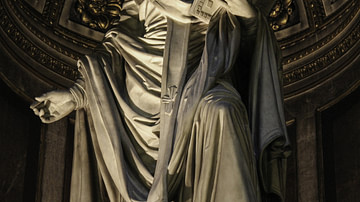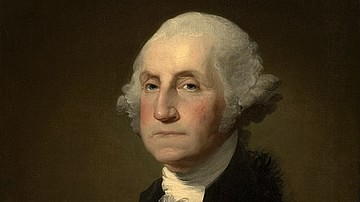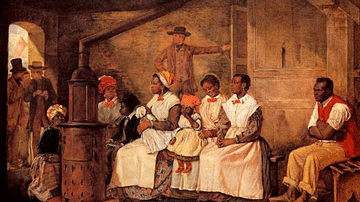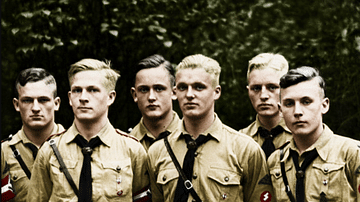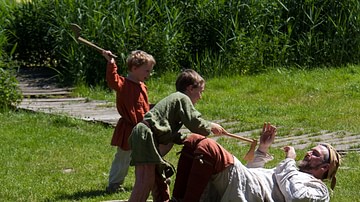The youth of George Washington (1732-1799), the first President of the United States, remains the least understood chapter of his life, shrouded in folklore and myths. Yet the experiences of his youth, and the bond he felt toward his older half-brother Lawrence, shaped the man he was to become and helped put him on the path toward revolution and the presidency.

This article examines what is known about the lineage and youth of George Washington, from the first time his great-grandfather set foot on the shores of Virginia in 1657 until George's own coming of age in 1753, a year before the shots fired at the Battle of Fort Necessity changed the trajectory of his own life and, it can be argued, of world history.
Tall, strong, and somewhat physically awkward, the young George Washington grew up on a plantation just outside of Fredericksburg, Virginia, and moved to Mount Vernon as his brother's ward shortly after the death of their father. He became a land surveyor at the age of 16, measuring over 60,000 acres of land along the unmapped western frontier of Virginia. When Lawrence contracted a fatal case of tuberculosis, George accompanied him to Barbados, the only time he ever left the boundaries of the future United States; while there, he had a short but painful bout with smallpox, and for the first time came face to face with the military might of Great Britain. He had experienced much by his 21st birthday in 1753, although nothing could have prepared him for what was still to come.
Family & Parentage
The story of the Washington family in Virginia begins with a shipwreck. On 28 February 1657, the merchant vessel Seahorse of London ran aground on the shoals of the Potomac River during a storm; laden with precious tobacco, the ship had just embarked on its return voyage to England. Among its crew was a young Englishman named John Washington (b. 1633), who had taken to a life at sea after his father, an Anglican rector, had had his properties confiscated for his support of the Royalists during the English Civil Wars (1642-1651). As the crewmen went to work repairing the Seahorse of London, John Washington befriended several locals including Anne Pope, the daughter of a wealthy Maryland planter. It was perhaps out of love for Anne – or perhaps because he spied more opportunity in America than on the open seas – that induced John to stay behind after the crewmen sailed the repaired vessel back to England. John Washington married Anne Pope in late 1658, with the marriage ultimately producing five children.
Before his death in August 1677, John Washington made quite an impression on his adoptive home of Virginia. He had purchased or inherited upwards of 5,000 acres of land, upon which tobacco was planted and harvested by both enslaved Africans and white indentured servants. John's eldest son, Lawrence (b. 1659) was therefore left with a decent inheritance and was perfectly poised to enter public service. Before the age of 25, he served as both the Justice of the Peace and in the House of Burgesses, cementing the place of the Washington family among the colony's landed gentry. Around 1686, he married Mildred Warner, the daughter of the Speaker of the House of Burgesses, with whom he would have three children: John (1692-1746), Augustine (1694-1743), and Mildred (1698-1747). Lawrence died an early death in 1698, after which his widow remarried to an English merchant, George Gale, and moved her children to Whitehaven, England, before she died in 1701. Gale took care of the orphaned Washington children, enrolling the boys in the nearby grammar school at Appleby.
Augustine Washington, the middle child of Lawrence and Mildred, returned to Virginia sometime before he came of age in 1715 to claim his inheritance. Called 'Gus' by family and friends, he was tall, blond, and muscular, and was said to have been as gentle as he was strong. Upon his 21st birthday, he inherited 1,000 acres of land as well as six enslaved people; his marriage to Jane Butler that same year added another 1,700 acres to his already considerable amount of property. The couple settled on Gus' main plot of land at Pope's Creek in Westmoreland County, Virginia, where construction soon began on a home called Wakefield. It was here that Jane gave birth to three surviving children: Lawrence (1718-1752), Augustine, Jr. (1720-1762), and Jane (1722-1735).

Like his own father, Augustine entered public life, serving as Justice of the Peace and sheriff for Westmoreland County. He also continued buying up properties, including a tract of land near Accokeek Creek, 8 miles (13 km) northeast of Fredericksburg. It was on this land that rich deposits of iron were discovered in the late 1720s; looking to capitalize on this, Augustine began negotiating with the Principio Company, an association of British ironmasters and merchants, to construct an ironworks on the land. In 1729, Augustine went to England to finalize negotiations with his new business partners only to discover upon his return that his wife Jane had died. Distraught though he was, it was not customary for Virginian widowers to stay single for long, and, on 6 March 1731, Augustine Washington was remarried to 23-year-old Mary Ball.
Childhood & Education
Mary Ball Washington gave birth to her firstborn son at Wakefield at 10 a.m. on 22 February 1732. His name was George. His birth would be followed by five younger siblings: Elizabeth (1733-1797), Samuel (1734-1781), John Augustine (1736-1787), Charles (1738-1799), and Mildred (1739-1740). In 1734, Augustine moved his rapidly growing family 60 miles (96 km) up the Potomac River to the Little Hunting Creek plantation, where he could keep a closer eye on his lucrative ironworks. He ordered the construction of a house on this property that would form the basis for Mount Vernon. Before long, Augustine moved the family once again, this time to the Ferry Farm estate near Fredericksburg, Virginia; it was here where George Washington spent much of his youth.
Not much is known about George's childhood; indeed, in terms of historical scholarship, it remains the murkiest chapter of his life. He was certainly raised on the Ferry Farm plantation, and likely attended a local school in Fredericksburg, where he excelled in the subjects of geometry, trigonometry, and mapmaking. Some of his school papers survive, in which he copied out sets of moral teachings from the book Rules of Civility and Decent Behavior in Company and Conversation; these 'rules', which included such counsel as "in the presence of others, sing not to yourself with a humming noise, nor drum with your fingers or feet", showed George how to be a proper Virginian gentleman, guidance he would follow for the rest of his life. Folkloric stories about George's childhood – such as the supposed instance in which he was unable to lie to his father about chopping down a prized cherry tree – were later fabricated, to fill in the gaps in this unknown part of his life.
In 1743, Augustine Washington unexpectedly died. At only 11 years old, George inherited Ferry Farm as well as ten enslaved people. Too young to fend for himself, he was sent to live with his eldest half-brother, Lawrence, who had inherited the Little Hunting Creek estate and had renamed it Mount Vernon, in honor of British Admiral Edward Vernon, his commanding officer in the War of Jenkins' Ear. George idolized and adored Lawrence and soon tried to emulate the "grace, bearing, and manners" of his refined older brother (Freeman, 5). Eventually, George would come to regard Lawrence as both a father figure and a best friend. Lawrence Washington seemed to be a good role model for the young George as he was quickly making a name for himself in Virginia. In 1744, he was elected to the House of Burgesses and, a few years later, helped found the Ohio Company, a land speculation company that was chartered to settle the uncolonized lands of the Ohio River Valley. Lawrence also married Anne Fairfax, the daughter of his influential neighbor Thomas Fairfax, whose patronage would soon affect George's life.
Surveying Career
After finishing his education, George's proficiency in mathematics led him to consider a career in land surveying, which at the time was considered a respectable path to wealth and social advancement. In 1748, at the age of 16, George Washington set out on an expedition into the wilderness of the Shenandoah Valley to survey the properties of Lawrence's father-in-law Thomas Fairfax. It was to be the first time George set foot off the lands where he had grown up on the Virginia Neck, and he kept a diary to recount his experiences on this, his first real adventure. Led by Thomas' son, George William Fairfax, the surveying party proceeded along the bank of the Potomac River, setting out on 14 March 1748; that night, after a long day of journeying, George was disappointed to find there was nothing to sleep on except a "thread bare blanket with double its weight of vermin such as lice fleas". Then, on 22 March, George encountered Native Americans for the first time, their party carrying a scalp. George recorded in his journal how one of the natives constructed a drum by stretching deerskin over a half-filled pot of water, while the others danced around a roaring fire.

This first expedition was, ultimately, a success, and George received his land surveyor's license the following year. Impressed with the young man's abilities, Thomas Fairfax used his influence to get George appointed as a land surveyor for the newly formed Culpeper County, on Virginia's western frontier. Over the course of the next three years, George Washington conducted 200 surveys, measuring a combined total of 60,000 acres of land. These surveying trips took him far beyond the limits of Culpeper County, and he was soon venturing into the Blue Ridge Mountains and other unsettled territories in the west. This experience would give him a lifelong interest in the western lands, an interest that influenced the choices that led to him taking up arms in both the French and Indian War and the American Revolution. He stopped surveying land professionally in 1752 but would continue to do so for his own properties for the rest of his life.
Trip to Barbados
In the spring of 1749, as George's land surveying career was taking off, Lawrence came down with a heavy cough. At first, he tried to ignore it and carry on with his duties, but the cough would not go away and became so bad that he had to take a leave of absence from the House of Burgesses in May. By early 1751, it was clear that the oldest Washington brother was suffering from tuberculosis (commonly known as 'consumption' in those days), prompting him to seek a more tropical climate in the hopes that the balmy air might restore his health. Barbados, a small island in the southeastern Caribbean, was known to be a popular destination for tuberculosis patients, leading Lawrence to select it as his destination. His wife Anne was unable to accompany him – she had an infant daughter to look after whose health she did not want to risk on a long voyage – so 19-year-old George agreed to go instead. The brothers' vessel set sail from the Potomac on 28 September 1751, arriving on the east coast of Barbados at 4 a.m. on 2 November.
The brothers disembarked and went to Bridgetown, the island's main settlement, and eventually found lodgings at the home of Captain Crofton, overlooking Carlisle Bay. As Lawrence consulted with his physicians, George marveled at the tropical landscape of Barbados, which was unlike anything he had ever seen, and found that he was 'perfectly ravished' by the island's beauty (mountvernon.org). He and Lawrence often dined at the homes of important Barbados officials, one of whom offered George a tour of Charles Fort on Needham Point. The 36-gun fort, which guarded the entrance to Carlisle Bay, was the first such fortress George had ever seen, and had a significant impact on the young Virginian; whereas previously he had given little thought to military matters, his glimpse of Britain's military might in Barbados fascinated him and may have convinced him to pursue a military career of his own once he returned to Virginia.
On 17 November, amidst the intoxicating rush of social life in Bridgetown, George came down with a fever. By the evening, he was complaining of a severe headache and pains in his back and sides, and small red dots appeared on his forehead three days later. George had contracted smallpox, one of the most feared diseases of his time – while it was much rarer in Virginia, it was common in the Caribbean. For several days, George was confined to bed, fighting his painful battle with the pox. But he was young and healthy and recovered soon enough, although his face was marred with the telltale scars that denoted a smallpox survivor. George would never forget his bout of smallpox, nor how close to death he had come. During the American Revolution, when a smallpox outbreak was ravaging the colonies, he would mandate that all his soldiers be inoculated against the disease, an act that several historians credit with having saved the Continental Army from destruction.
Death of Lawrence
On 21 December, shortly after his recovery, George sailed for Virginia alone; Lawrence, whose condition had not much improved, decided to try Bermuda instead but urged his younger brother to return home. George arrived at Yorktown on 28 January 1752 and immediately went on to Williamsburg to pay his respects to the governor, Robert Dinwiddie, who would soon play an important role in his life. He then returned to Mount Vernon and fell hopelessly in love with Elizabeth 'Betsy' Fauntleroy, daughter of a respected family. This was far from the first time George had been in love; as a teenager, he had written poetry about girls he had crushes on, but he had never formally courted any of them. Now that he was of a marriageable age, he made two romantic overtures to Betsy Fauntleroy but was rejected each time. It would be another seven years before he would marry the widowed Martha Dandridge Custis, his future First Lady.
Sometime in early June 1752, Lawrence returned from Bermuda, but not because he had recovered; having realized he was dying, he had decided to "hurry home to [his] grave" so that he might put his affairs in order and die in the land on which he had been born (Freeman, 31). Lawrence completed and signed his will on 20 June and died six days later at the age of 34; the grief-stricken George was entrusted with putting together the funeral arrangements and building a burial vault for his beloved half-brother. The ownership of Mount Vernon passed to Lawrence's widow, Anne, but because she did not live there, she agreed to lease the property to George; upon Anne's own death in 1761, George became the official owners of Mount Vernon (Lawrence and Anne's only daughter, Sarah, had died in infancy in 1754).
Conclusion: Washington the Soldier
In 1753, George Washington turned 21, considered the age of maturity in Colonial America. Like his father, he was physically strong and stood over 6 feet tall (183 cm) in his stockings, towering over most of his contemporaries. He had grey-blue eyes and reddish hair that he powdered and curled in the fashion of the time. He was known to be a graceful dancer, a skilled horseback rider, and fond of hunting, traits that marked him out as a proper Virginian gentleman. Yet like other young gentlemen of that time, George Washington thirsted for adventure; the awe-inspiring sight of Charles Fort in Barbados had led him to dream of martial glory, much like his idolized brother Lawrence had achieved at the Siege of Cartagena during his service in the War of Jenkins' Ear.
He would soon have his chance. In 1753, word reached Virginia that the French had begun to build forts in the Ohio River Valley, on lands that had been claimed by the Ohio Company, which had been partially founded by Lawrence Washington. Governor Dinwiddie, who was an investor in the Ohio Company, dispatched George to demand that the French leave the territory at once. George Washington's decision to accept the mission, although undoubtedly fueled by his lust for glory, was also made from the experiences of his youth. He was compelled to defend the claims of the Ohio Company both out of love and loyalty to his older brother and because of his own experiences as a surveyor of western lands, lands he believed rightfully belonged to Virginians. Whatever his reasons, Washington's journey into the West in 1753 would change the trajectory of his life, putting him on the path to becoming a soldier and, ultimately, president of a nation he would help forge, the United States of America.



